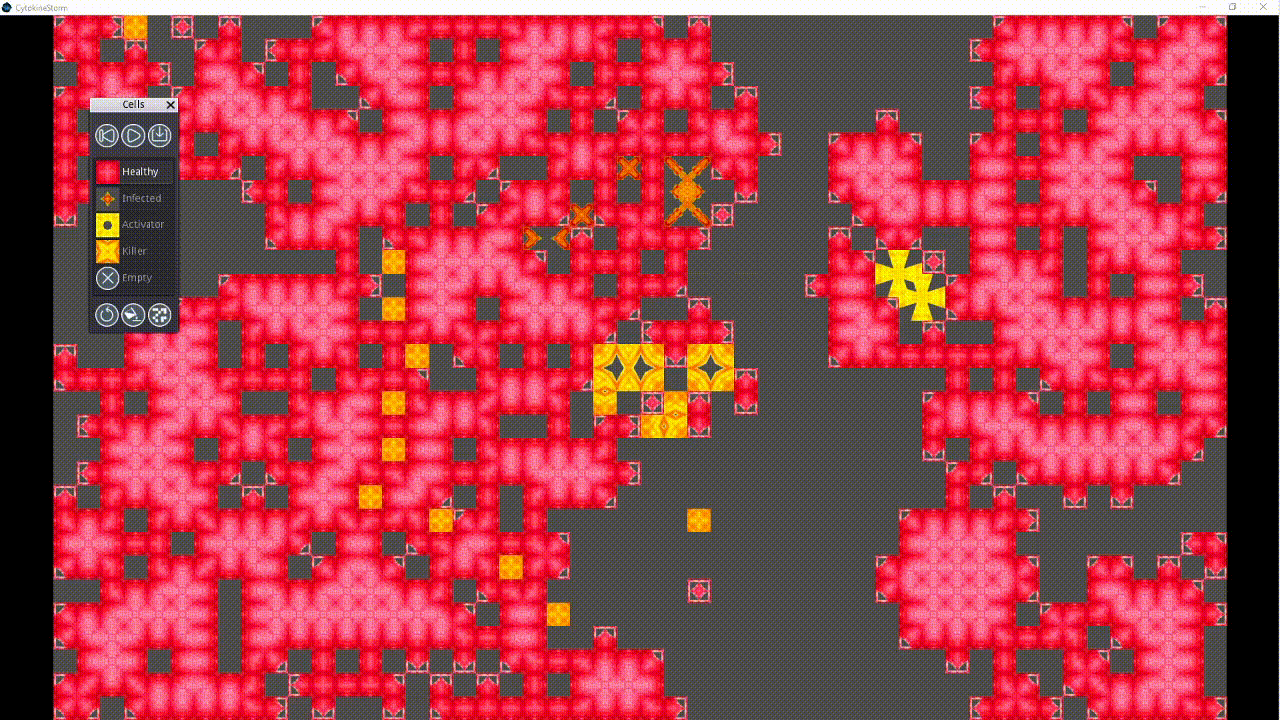[watch film] [about]
The Call of the Silent Cell film incorporates a 3D simulation of immune system behaviour that was developed in workshops with Oxford college students.
Your body is teeming with killer cells waiting for a signal. When, where and how this message will be issued is unclear. What is certain is that you might not like the target. Assassin cells, whose job it is to protect our bodies from bad actors can turn against us. In this workshop Key Stage 5 students from the Interactive Media & Computer Arts course at Activate Learning, City of Oxford College and EMBS Community College students explored the rules that govern the behaviour of our immune system, using gaming structure and artificial life to unmask the mechanisms that lead to autoimmune disease where, in true double agent style, our cells betray us.
The Science Behind Call of the Silent Cell
In the film you are transported into the body during a storm of cellular behaviour known as a cytokine storm. Cytokines are substances that are made in our cells and ‘signal’ to the immune system. For example they may indicate an infection is under way so that your immune system can launch a response.

A cytokine storm can occur when something goes wrong and your body releases too many signals. This can cause the immune system to overreact and damage otherwise healthy cells. In the film you see bright cells that are responding to signals of infection. You will notice that waves of light flow repeatedly over the same area. This happens because we have changed the rules of the simulation to work like a broken immune system.
How might our immune system break? Immune systems are very complex. In the simulation you see in the film there are four cell states that represent the behaviour of an immune system:
- Healthy cell,
- Damaged or infected cells,
- Activator cells,
- Killer cells.
Activator cells signal the presence of infected or damaged cells and in response increase in number.
This stimulates the creation of killer cells in the region where this damage or infection has occurred. Killer
cells will then cause cells at this location to die. For a healthy immune response all these interactions need
to be balanced.
In the student workshop participants were able to change the balance between these four cell states to see how it affected the overall behaviour of the system.

If you would like to build your own model of an immune system to explore these principles further boredomresearch have created a free six part tutorial series. The collection of processing js sketches can be found here

The problem with a dysfunctional immune system is that the messages used to trigger a response can become confused. A change to the cellular environment can disorient the behaviour of immune cells. Moths normally use the moon for navigation. The introduction of artificial street lights makes it difficult for the moths to navigate as they can not tell the difference between the two.

In the film we see moths being drawn into the light emitted from the cytokine storm. It is symbolic of a confusion caused by a changed environment. Our immune system has to adapt to new situations. Scientists studying the immune system are starting to understand how changes to the gut environment are disorienting the immune system.

The biggest interface between the body and other living organisms is in our gut. The gastrointestinal tract is full of microbes, tiny organisms, that break down our food and release energy. Our gut is home to a vast ecosystem of microbial life, known as our ‘microbial flora’.
In the film we are introduced to this environment as a sea of ‘fingers’ called villi; these shapes provide the vast surface required by our microbial flora.

In nature there are sometimes advantages to hiding. The Peppered Moth seen in the film has patterned wings that allow it to hide on birch trees. The wings ‘mimic’ the pattern of the tree.

The immune system has to be able to distinguish between healthy parts of the body and those that are infected and damaged. Some microbes that are important to us may ‘look’ like or mimic other parts of us so that they can hide from the immune system. If the environment changes like in the film when the moths are disturbed and the tree disappears they attract our attention.
Changes in our microbial flora can disorient the immune system in the same way. Things suddenly become visible to the immune system that would otherwise have been hidden. This can cause the immune system to become confused and attack healthy parts of the body.
Current research is raising concerns that changes to our diet are disturbing the complex ecology of the microbiome leading to an ecological crisis in our gut that in turn may be driving a steady increase in immune dysfunction.
